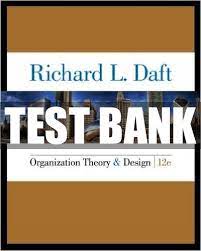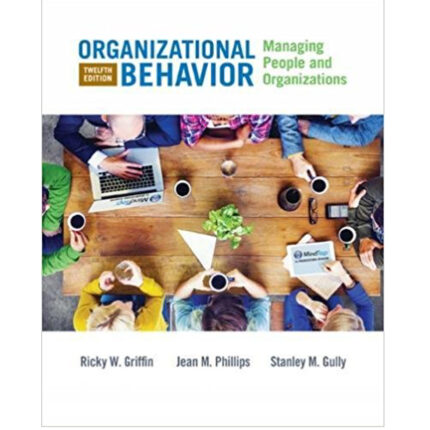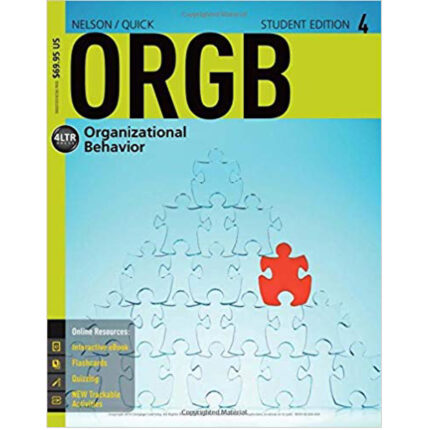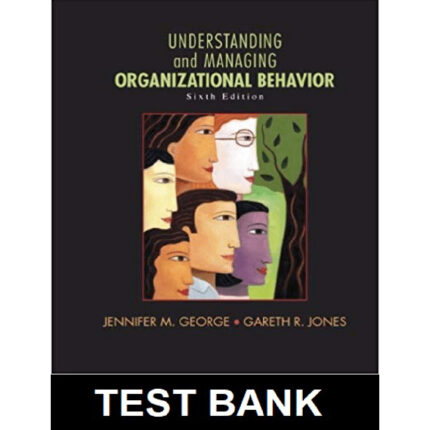Overview
1. _____ occurs occasionally, with periods of relative stability, and managers can respond with technical, product, or structural innovations as needed.
a. Disruptive change
b. Episodic change
c. Structural change
d. Continuous change
ANSWER: b
RATIONALE: Feedback: Episodic change is what many long-time managers are accustomed to. This type of change occurs occasionally, with periods of relative stability, and managers can respond with technical, product, or structural innovations as needed.
POINTS: 1
LEARNING OBJECTIVES: ORGT.DAFT.16.11-01 – 11-01
NATIONAL STANDARDS: United States – AACSB: Analytic
TOPICS: The Strategic Role of Change
KEYWORDS: Bloom’s: Remember
2. _____ occurs frequently, with fewer and shorter periods of stability.
a. Disruptive change
b. Episodic change
c. Structural change
d. Continuous change
ANSWER: d
RATIONALE: Feedback: Most organizations today experience continuous change because of a rapidly shifting environment. This type of change occurs frequently, with fewer and shorter periods of stability.
POINTS: 1
LEARNING OBJECTIVES: ORGT.DAFT.16.11-01 – 11-01
NATIONAL STANDARDS: United States – AACSB: Analytic
TOPICS: The Strategic Role of Change
KEYWORDS: Bloom’s: Remember
3. The Research and Development Unit of Blue Lagoon, a multinational electronic brand, has released another update to Lagoon X4848i, a smartphone. This latest update is their fourth within a year. This adaptation to environmental shift is an example of the company’s response to _____.
a. disruptive change
b. continuous change
c. episodic change
d. annual change
ANSWER: b
RATIONALE: Feedback: This adaptation to environmental shift is an example of Blue Lagoon’s response to continuous change. Most organizations today experience continuous change because of a rapidly shifting environment. This type of change occurs frequently, with fewer and shorter periods of stability.
POINTS: 1
LEARNING OBJECTIVES: ORGT.DAFT.16.11-01 – 11-01
NATIONAL STANDARDS: United States – AACSB: Reflective Thinking
TOPICS: The Strategic Role of Change
KEYWORDS: Bloom’s: Apply
4. Which of the following is a difference between episodic change and continuous change?
a. Episodic change occurs occasionally, while continuous change occurs frequently.
b. Episodic change occurs with fewer and shorter periods of stability, while continuous change occurs with frequent and longer periods of stability.
c. Episodic change requires complete replacement of an existing product, while continuous change requires partial replacement of an existing product.
d. Episodic change enables distinctive competence, while continuous change disables distinctive competence.
ANSWER: a
RATIONALE: Feedback: Episodic change is what many long-time managers are accustomed to. This type of change occurs occasionally, with periods of relative stability, and managers can respond with technical, product, or structural innovations as needed. Most organizations today, however, experience continuous change because of a rapidly shifting environment. This type of change occurs frequently, with fewer and shorter periods of stability.
POINTS: 1
LEARNING OBJECTIVES: ORGT.DAFT.16.11-01 – 11-01
NATIONAL STANDARDS: United States – AACSB: Analytic
TOPICS: The Strategic Role of Change
KEYWORDS: Bloom’s: Understand
5. _____ refers to innovations in products or services that typically start small and end up completely replacing an existing product or service technology for producers and consumers.
a. Disruptive innovation
b. Organizational innovation
c. Open innovation
d. Culture innovation
ANSWER: a
RATIONALE: Feedback: Disruptive innovation refers to innovations in products or services that typically start small and end up completely replacing an existing product or service technology for producers and consumers. Companies that initiate a disruptive innovation typically win big; companies affected by a disruptive innovation may be put out of business.
POINTS: 1
LEARNING OBJECTIVES: ORGT.DAFT.16.11-01 – 11-01
NATIONAL STANDARDS: United States – AACSB: Analytic
TOPICS: The Strategic Role of Change
KEYWORDS: Bloom’s: Remember
6. _____ are changes in an organization’s production process, including its knowledge and skill base, that enable distinctive competence.
a. Strategy and structure innovations
b. Product and service innovations
c. Technology innovations
d. Culture innovations
ANSWER: c
RATIONALE: Feedback: Technology innovations are changes in an organization’s production process, including its knowledge and skill base, that enable distinctive competence. These changes are designed to make production more efficient or to produce greater volume.
POINTS: 1
LEARNING OBJECTIVES: ORGT.DAFT.16.11-01 – 11-01
NATIONAL STANDARDS: United States – AACSB: Analytic
TOPICS: The Strategic Role of Change
KEYWORDS: Bloom’s: Remember
7. _____ pertain to the administrative domain in an organization.
a. Technology innovations
b. Strategy and structure innovations
c. Culture innovations
d. Product and service innovations
ANSWER: b
RATIONALE: Feedback: Strategy and structure innovations pertain to the administrative domain in an organization. These innovations include changes in organization structure, strategic management, policies, reward systems, labor relations, coordination devices, management information and control systems, and accounting and budgeting systems.
POINTS:1
LEARNING OBJECTIVES: ORGT.DAFT.16.11-01 – 11-01
NATIONAL STANDARDS: United States – AACSB: Analytic
TOPICS: The Strategic Role of Change
KEYWORDS: Bloom’s: Remember
8. _____ refer to changes in the values, attitudes, expectations, beliefs, abilities, and behavior of employees.
a. Technology innovations
b. Strategy and structure innovations
c. Culture innovations
d. Product and service innovations
ANSWER: c
RATIONALE: Feedback: Culture innovations refer to changes in the values, attitudes, expectations, beliefs, abilities, and behavior of employees. Culture innovations pertain to changes in how employees think; these are changes in mindset rather than technology, structure, or products.
POINTS: 1
LEARNING OBJECTIVES: ORGT.DAFT.16.11-01 – 11-01
NATIONAL STANDARDS: United States – AACSB: Analytic
TOPICS: The Strategic Role of Change
KEYWORDS: Bloom’s: Remember
9. _____ is considered the adoption of a new idea or behavior by an organization.
a. Organizational environment
b. Organizational innovation
c. Organizational change
d. Organizational behavior
ANSWER: c
RATIONALE: Feedback: In the research literature on innovation, organizational change is considered the adoption of a new idea or behavior by an organization. Organizational innovation, in contrast, is the adoption of an idea or behavior that is new to the organization’s industry, market, or general environment.
POINTS: 1
LEARNING OBJECTIVES: ORGT.DAFT.16.11-02 – 11-02
NATIONAL STANDARDS: United States – AACSB: Analytic
TOPICS: Elements for Successful Change
KEYWORDS: Bloom’s: Remember
10. _____ is the adoption of an idea or behavior that is new to an organization’s industry, market, or general environment.
a. Organizational environment
b. Organizational innovation
c. Organizational change
d. Organizational behavior
ANSWER: b
RATIONALE: Feedback: In the research literature on innovation, organizational change is considered the adoption of a new idea or behavior by an organization. Organizational innovation, in contrast, is the adoption of an idea or behavior that is new to the organization’s industry, market, or general environment.
POINTS: 1
LEARNING OBJECTIVES: ORGT.DAFT.16.11-02 – 11-02
NATIONAL STANDARDS: United States – AACSB: Analytic
TOPICS: Elements for Successful Change
KEYWORDS: Bloom’s: Remember













Reviews
There are no reviews yet.